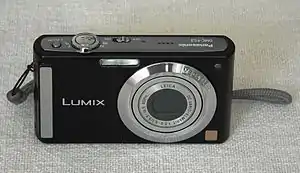Panasonic Lumix DMC-FS3
The Panasonic Lumix DMC-FS3 is a digital ultracompact camera announced by Panasonic on January 29, 2008.
 Black colour variant of the DMC-FS3 | |
| Overview | |
|---|---|
| Maker | Panasonic |
| Released | 2008 |
| Lens | |
| Lens | 33-100mm equivalent |
| F-numbers | f/2.8-f/5.1 at the widest; narrow f/8.0-f/14.0[1] |
| Sensor/medium | |
| Sensor type | CCD |
| Sensor size | 5.744 x 4.308mm (1/2.5 inch type) |
| Maximum resolution | 3264 × 2448 (8 megapixels) |
| Film speed | ISO 100 to 6400 [2] |
| Recording medium | SD, SDHC or MMC memory card; internal memory |
| Storage media | SD-HC (32 GB), 50 MB internal |
| Focusing | |
| Focus areas | 9 focus points |
| Flash | |
| Flash | Xenon |
| Shutter | |
| Shutter speeds | 1/2000s to 60s |
| Continuous shooting | 3 frames per second (full resolution), 7 frames per second (2.5 megapixels) |
| Viewfinder | |
| Viewfinder | No |
| Image processing | |
| White balance | Yes |
| General | |
| Video recording | Max. 848×480 (WVGA) at 30 fps |
| LCD screen | 2.5 inches with 230,000 dots |
| Optional battery packs | Yes |
| Optional accessories | Water-resistant case |
| AV Port(s) | Composite AV, PictBridge, Mass Storage, Media Transfer Protocol |
| Dimensions | 95 x 53 x 23mm (3.74 x 2.1 x 0.89 inches) |
| Weight | 158g including battery |
| Made in | Taiwan |
Exterior
The DMC-FS3 has a metallic case and is available in silver, black, blue and pink colour options.
Its exterior, user interface and firmware are nearly identical to that of the Panasonic Lumix DMC-FS5.
The device is equipped with an autofocus lamp and an Xenon flash.
Lens
Its Leica lens has an aperture of f/2.8 to f/5.1 and f/8.0 to f/14.0 for brighter environments, respectively at a 35mm equivalent focal length of 33mm to 100mm.
Burst shot
The DMC-FS3 supports burst shots of three full-resolution photos per second and seven two-megapixel photos per second.
Video recording
Video recording is supported at the following resolutions, each with 30fps and 10fps options:
- 848×480 (16:9 WVGA)
- 640×480 (4:3 VGA)
- 320×240 (4:3 QVGA)
Motion JPEG is used for video recording. Optical image stabilization is enabled during video recording.[2][3][4] [5]
Connectivity
The DMC-FS3 can be connected to a television via composite A/V and also supports Mass Storage, Media Transfer Protocol and PictBridge.[2][3][5]
Storage
The DMC-FS3 supports SD-HC memory cards (up to 32 GB) and has 50 megabytes of internal storage. The SD card slot is backwards-compatible with Multimedia cards. [2][3]
Display
The 2.5" QVGA RGB screen is able to adapt brightness and contrast levels automatically to the surrounding. While the device lacks an ambient light sensor, the brightness is measured through the image sensor.[5][6]
User interface
The DMC-FS3 has an additional “E.Zoom” (easy zoom) button that allows optically fully zooming in an out with one button press.
The image browser, next to standard features such as miniature image browsing and zooming, slide shows, there is a calendar viewing mode
Photos can be marked as favourites, protected from accidental deletion and labelled. [2][3][5]
Scene modes
The DMC-FS3 supports various scene modes such as Landscape, which avoids focussing on a window/windshield.[5]
It is equipped with face recognition and a then new “Intelligent Automatic” (“iA”) mode that automatically selects the scene mode it deems most suitable.
Accessories
Accessory options for the device include a water-protected case.[5]
References
- Full-size sample photos from Panasonic Lumix DMC-FS3
- DMC-FS3 specification sheet on SnapSort
- Panasonic Lumix DMC-FS3 specifications – Digital Photography Review (DPreview)
- Zerlauth, Sixta (2009). "Immer dabei: Die Lumix DMC-FS3". www.explorermagazin.de (in German). Retrieved 2020-07-15.
- DMC-FS3 and DMC-FS5 owner's manual
- "Panasonic Lumix DMC-FS3 Digital Camera (Blue)". www.bhphotovideo.com. B&H Photo Video.